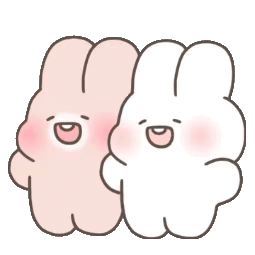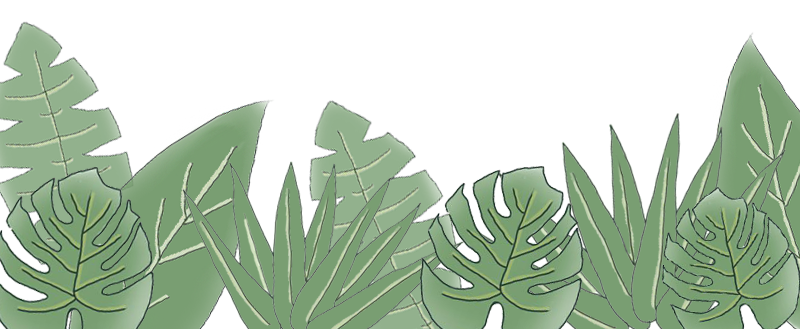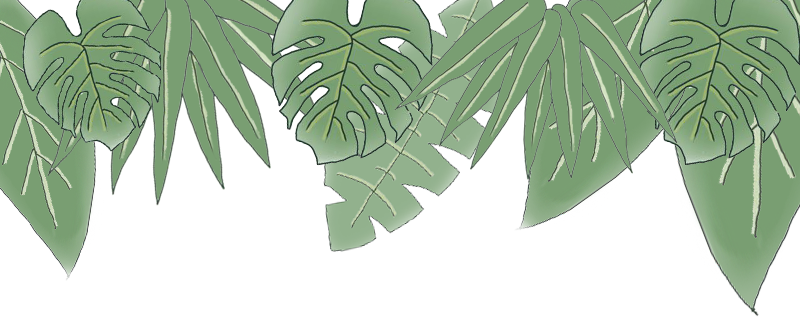
Huang Lian
(Coptis)
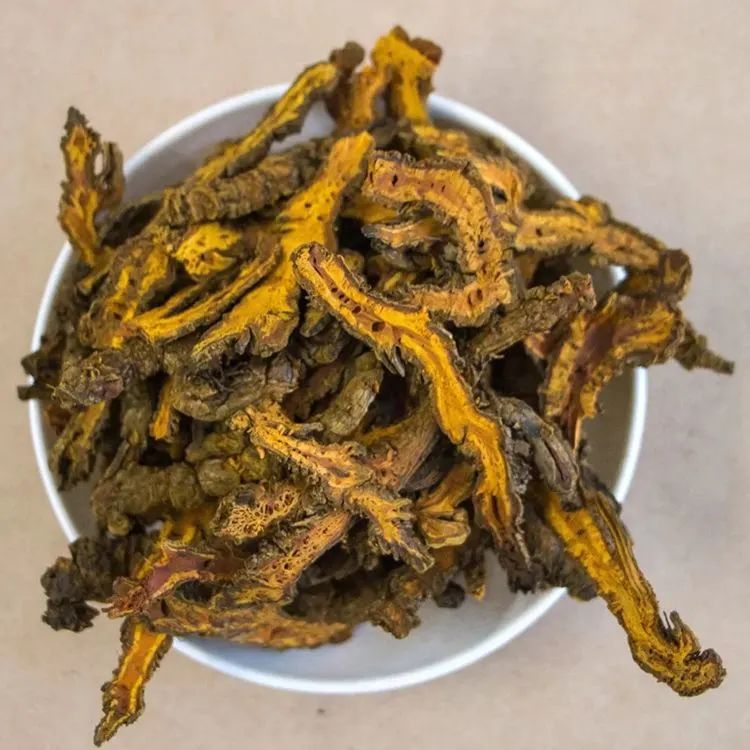
Source
This herb is the dried rhizome of the Ranunculaceae family plants: Coptis chinensis Franch., Coptis deltoidea C.Y.Cheng et Hsiao, or Coptis teeta Wall. The three types are commonly referred to as “Wei Lian”, “Ya Lian”, and “Yun Lian”. Related Names Yuan Lian, Wei Lian, Ya Lian, Yun Lian, Ji Zhua Lian, Chuan Lian, Wang Lian, Zhi Lian, Xuan Lian, Gu Lian, Chuan Huang Lian, Emei Lian, Gu Yong Lian.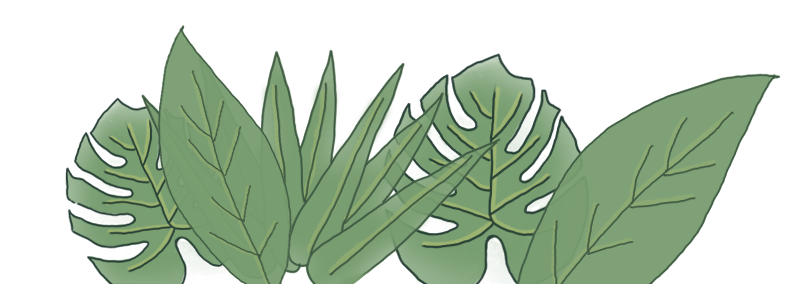

Origin
Wei Lian is mainly produced in Shizhu County, Chongqing, and in Hongya and Emei in Sichuan. It is also found in Hubei, Shaanxi, and Gansu, primarily cultivated. It is the main source of commercial Huang Lian. Ya Lian is mainly produced in Hongya and Emei, Sichuan, and is cultivated, with very few wild specimens. Yun Lian is mainly produced in Deqin, Yunnan, and southeastern Tibet, originally wild but now cultivated.Harvesting and ProcessingHarvest in autumn, remove fibrous roots and soil, dry, and remove residual fibrous roots.Identification of PropertiesHerb: Wei LianOften clustered, usually curved, resembling chicken claws, single rhizome length 3-6 cm, diameter 0.3-0.8 cm. Surface gray-yellow or yellow-brown, rough, with irregular nodular protrusions, fibrous roots, and remnants of fibrous roots; some internodes have smooth surfaces like stems, commonly referred to as “crossing the bridge”. The upper part often retains brown scale leaves, and the tip usually has remnants of stems or petioles. Hard texture, uneven fracture surface, orange-red or dark brown cortex, fresh yellow or orange-yellow wood, arranged radially, with some hollow pith. Slightly aromatic, extremely bitter taste.Ya Lian:Mostly single stems, slightly cylindrical, slightly curved, length 4-8 cm, diameter 0.5-1 cm. “Crossing the bridge” is longer. The tip has a small amount of residual stem.
Yun Lian:
Curved and hook-shaped, mostly single stems, relatively small.
Processed Product: Huang Lian Slices:
Irregular thin slices, outer skin gray-yellow or yellow-brown, rough, with small fibrous roots. Cut surface or broken surface fresh yellow or red-yellow, with radial texture, slightly aromatic, extremely bitter.
Wine Huang Lian:
Resembles Huang Lian slices, with a deeper color. Slight wine aroma.
Ginger Huang Lian:
Resembles Huang Lian slices, surface brown-yellow. Has a spicy ginger flavor.
Yu Huang Lian:
Resembles Huang Lian slices, surface brown-yellow. Has a spicy aroma of Wu Zhu Yu (Evodia rutaecarpa).
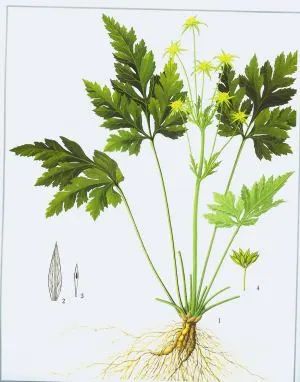
Taste and Meridian Affinity
Bitter, cold. Enters the Heart, Liver, Stomach, and Large Intestine meridians. CharacteristicsThis herb is extremely bitter and cold, clearing heat and drying dampness, with strong medicinal properties, primarily entering the Heart and Stomach meridians, and also affecting the Liver and Large Intestine meridians. It acts mainly on the Heart and Middle Jiao, effectively clearing Heart and Stomach fire, and eliminating damp-heat from the Middle Jiao, making it a key herb for treating damp-heat and fire stagnation.FunctionsClears heat, dries dampness, drains fire, and detoxifies.
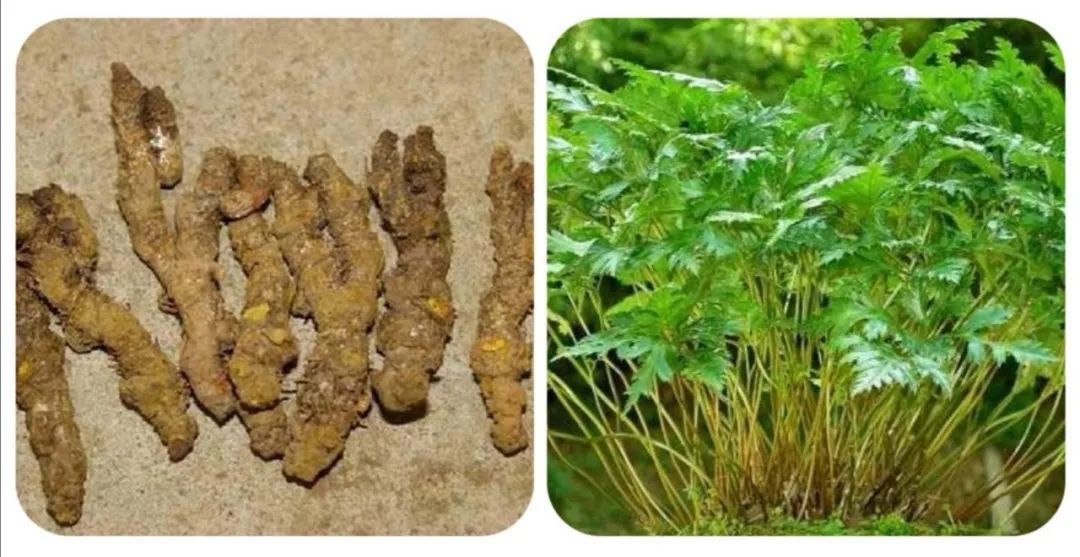
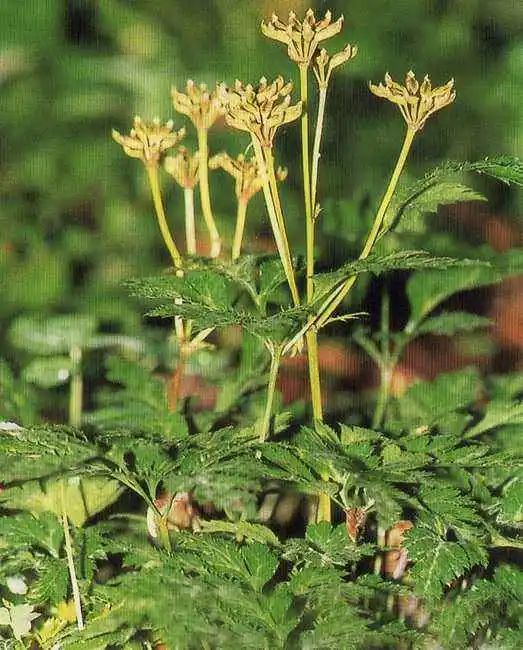
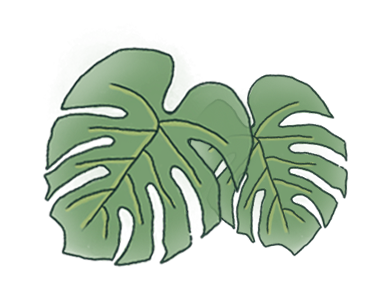
Indications
(1) Damp-heat causing fullness, vomiting, diarrhea, and jaundice.(2) Febrile diseases with high fever, irritability, delirium, internal heat causing restlessness and insomnia, Stomach fire toothache, and sores on the mouth and tongue.(3) Liver fire invading the Stomach causing vomiting and acid reflux.(4) Blood heat causing bleeding, carbuncles, red and painful eyes, ear canal abscesses, and febrile rashes.CompatibilityHuang Lian with Mu Xiang (Aucklandia lappa)Huang Lian is bitter and cold, functions to clear heat, dry dampness, drain fire, and detoxify; Mu Xiang is warm and pungent, functions to regulate Stomach Qi stagnation and relieve pain. The combination of these two herbs clears heat, dries dampness, detoxifies, regulates Qi, and relieves pain, effectively treating damp-heat diarrhea, abdominal pain, and tenesmus.Huang Lian with Wu Zhu YuHuang Lian is bitter and cold, functions to clear heat, dry dampness, and drain fire; Wu Zhu Yu is warm and pungent, functions to dry dampness, soothe the Liver, and descend Qi. The combination of these two herbs clears heat, drains fire, dries dampness, and soothes the Liver and harmonizes the Stomach to control acid, effectively treating Liver fire invading the Stomach and damp-heat obstruction causing vomiting and acid reflux.Huang Lian with Ban Xia (Pinellia ternata) and Gua Lou (Trichosanthes fruit)Huang Lian is bitter and cold, functions to clear heat, dry dampness, and drain fire; Ban Xia is warm and pungent, functions to dry dampness, transform phlegm, and disperse masses; Gua Lou is sweet and cold, functions to clear heat, transform phlegm, and regulate Qi to open the chest. The combination of these three herbs drains fire, transforms phlegm, and disperses masses, effectively treating phlegm-fire obstructing the chest.Dosage and AdministrationFor internal use: decoction, 2-10g; or in pills or powders. For external use: appropriate amount, ground into powder for application. Raw Huang Lian is better for draining fire, detoxifying, and drying dampness, clearing the Heart and Large Intestine fire. Wine-fried Huang Lian directs the herb upward and can moderate its bitter and cold nature. Stir-fried with ginger juice or Wu Zhu Yu, it mitigates the bitter and cold nature that harms the Stomach and enhances the effect of descending and stopping vomiting. Wu Zhu Yu also treats Liver Qi stagnation transforming into fire. PrecautionsThis herb is extremely bitter and cold; excessive or prolonged use can harm the Spleen and Stomach, so the internal dosage should not be too large, and long-term use is not advisable. It is contraindicated in cases of Stomach cold with vomiting or Spleen deficiency with diarrhea.PharmacologyThis herb has antipyretic, antibacterial, antiviral, anti-parasitic, anti-inflammatory, anti-allergic, immune-enhancing, anti-tumor, anti-arrhythmic, myocardial ischemia, blood pressure-lowering, gastrointestinal smooth muscle inhibition, anti-ulcer, choleretic, blood sugar-lowering, platelet aggregation inhibition, and central nervous system inhibition effects.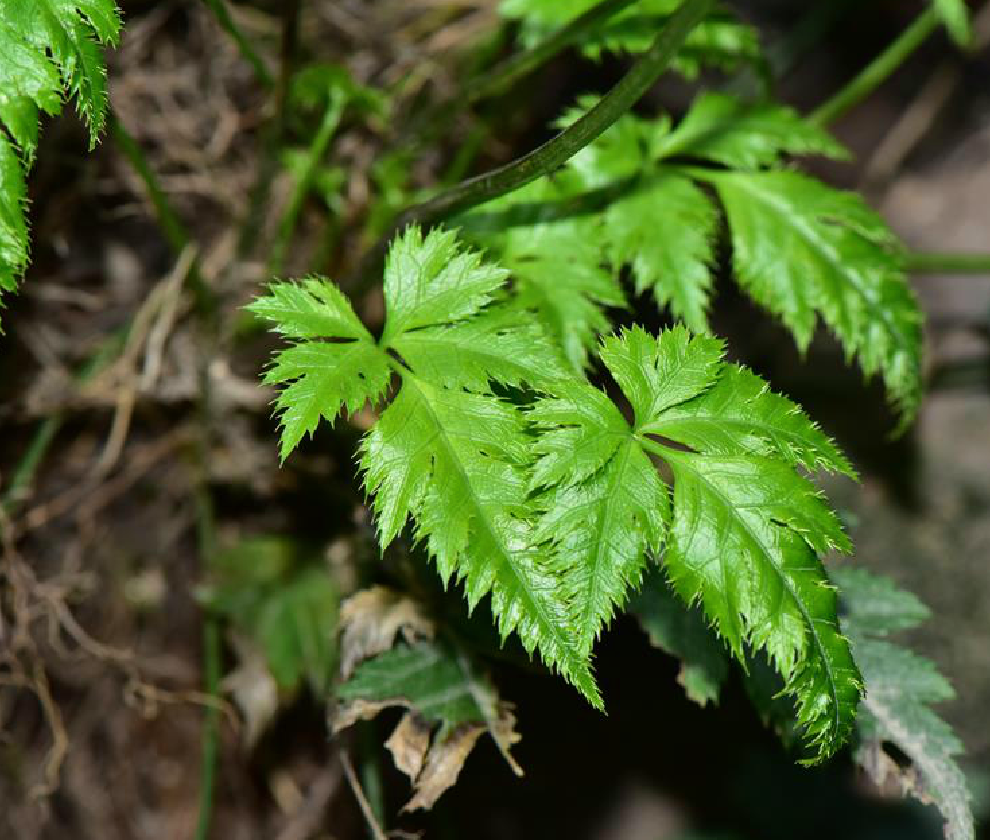


Memorable Notes
Huang Lian, when stir-fried, clears heat and dries dampness; when raw, drains fire and detoxifies. “A mute person eating Huang Lian, unable to express the bitterness”; this herb has been known since childhood, so no tricks are needed. As for the three Huang herbs: Huang Qin, Huang Lian, Huang Bai, it is easier to remember them together!Provided by Caiyun Chasing the Moon 39:Huang Qin clears the fire of the upper Jiao, Huang Lian clears the fire of the middle Jiao, Huang Bai clears the fire of the lower Jiao.Provided by qzq200412:Huang Lian—clears heat, dries dampness, drains fire, detoxifies.Huang Bai—clears heat, dries dampness, drains fire, eliminates bone steaming.Huang Qin—clears heat, dries dampness, drains fire, stops bleeding, calms the fetus.Long Dan Cao—clears heat, dries dampness, drains Liver and Gallbladder fire.For damp-heat fire toxicity, use Huang Lian; Huang Bai eliminates steaming; Huang Qin calms blood and stabilizes the fetus; Long Dan specializes in draining Liver and Gallbladder fire.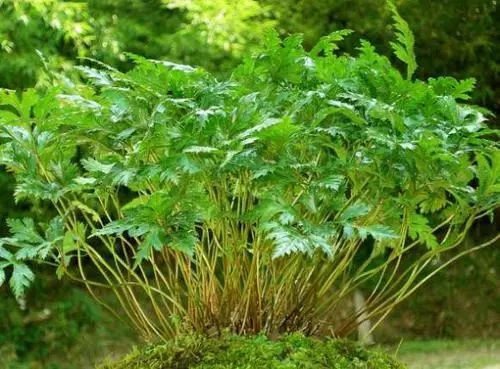

Story
Once upon a time, on Huangshui Mountain, where the Tujia people lived, there was a doctor named Tao. He had a garden dedicated to growing medicinal herbs, which he used to treat people. Due to his excellent medical skills, people from far and wide came to seek his help. Since Doctor Tao was often away, he hired a helper named Huang to manage the garden.
Doctor Tao’s daughter, Mei Wa, was beautiful, intelligent, and lively, cherished by her parents. Mei Wa also enjoyed planting flowers and herbs, and every morning, her first task was to check on the flowers and herbs in the garden.
One morning in the first month, when the frost had not yet melted and the cold air was biting, Mei Wa went to the garden and saw that the flowers had not bloomed and the grass had not sprouted. She opened the back door and walked along the path up the mountain. Suddenly, she saw a small green flower blooming by the roadside. The more she looked, the more she liked it, so she loosened the surrounding soil with her fingers, dug it up by the roots, and planted it in the garden. The helper, seeing this wild grass blooming in the cold January, also liked it very much and watered it every day, fertilizing it monthly. The grass grew more and more lush, and later it produced seeds. The helper scattered the seeds in the garden, and the next year, more green flowers bloomed.
Unexpectedly, Mei Wa fell ill with a strange disease, feeling hot all over, vomiting, and having diarrhea. In just three days, she became skin and bones. Doctor Tao was away treating patients, so Mei Wa’s mother had to invite another local doctor to treat her. This doctor was a friend of Doctor Tao and was very attentive in his diagnosis. However, after three doses of medicine, there was no improvement; her stomach was getting worse, and she even started to have blood in her stool. Her mother stayed by her side, worried sick, unable to eat or sleep, and cried at the thought of her daughter’s illness.
The helper, seeing this, was very anxious. What to do? Suddenly, he remembered the green flower. A few days ago, he had a sore throat and accidentally chewed a leaf from it. Although it was extremely bitter, after an hour, his sore throat had improved. He thought, could this flower be used as medicine for Mei Wa’s illness? It was worth a try. With that thought, he pulled up a whole plant with roots and leaves, boiled it into a bowl of water, and while Mei Wa’s mother was cooking, he brought it to Mei Wa to drink. To his surprise, after drinking it in the morning, she felt much better by the afternoon; after two more doses, she was completely healed. When Doctor Tao returned and learned what had happened, he was very touched and repeatedly thanked the helper, saying: “Mei Wa suffered from damp-heat in the intestines and stomach; only a medicine that clears heat and dries dampness could cure her. This little green flower seems to have the effect of clearing heat and drying dampness!”
Because this helper’s surname was Huang and his name was Lian, in gratitude, the herb was named Huang Lian.



Produced by I Pharmaceutical and Food Institute
Edited by I Luo Yeting
Chief Editor | Song Zhihui
Reviewed | Sun Yunli
